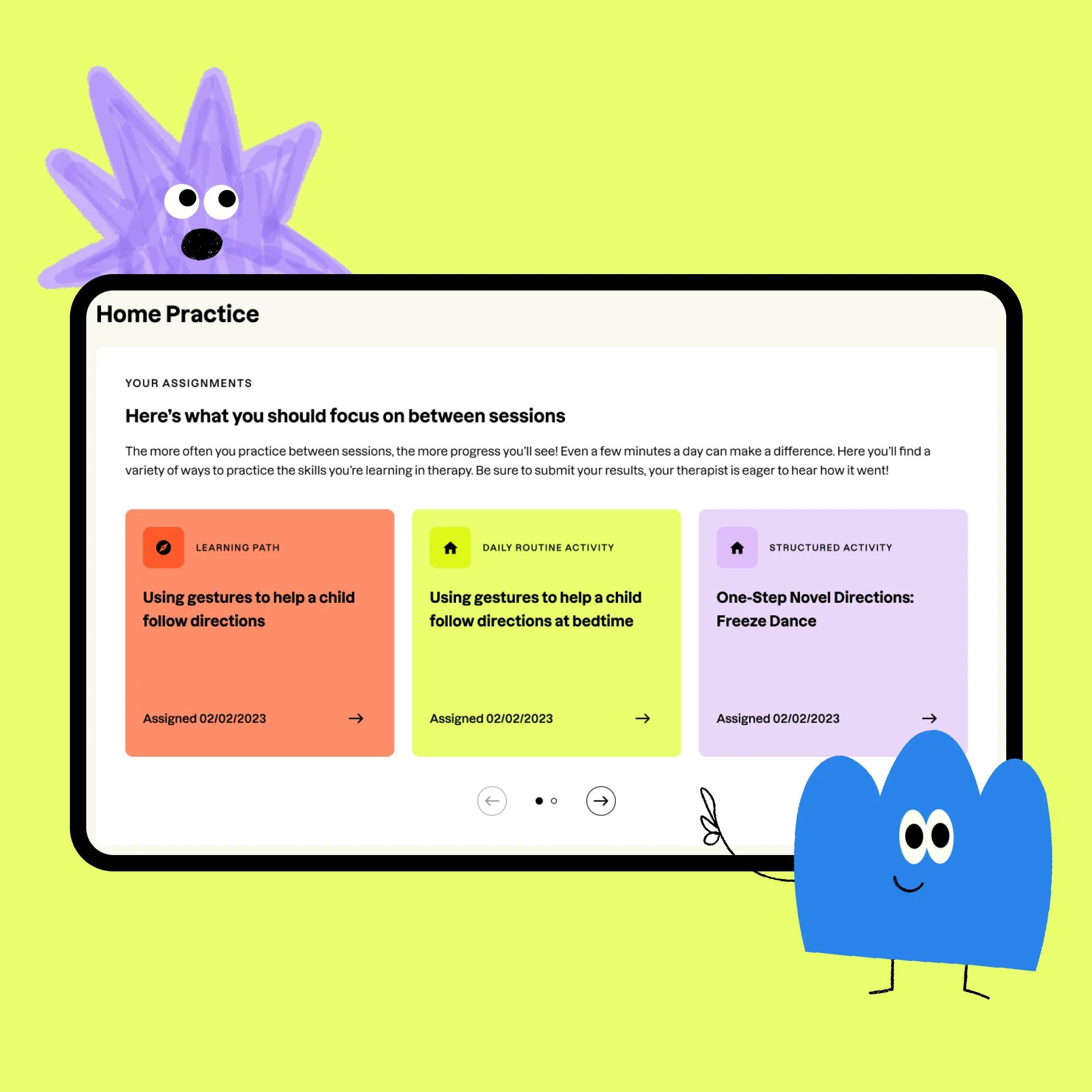
The Complete Guide to Voice Disorders: Signs, Causes, and How Voice Therapy Helps
 Alexis Irazoque, M.S., CCC-SLP
Alexis Irazoque, M.S., CCC-SLP
Our voices help us connect with others, express ourselves, and show who we are. Just like a fingerprint, every voice is unique. But what happens when your voice doesn’t sound or feel quite right?
A voice disorder can make it hard to speak clearly or comfortably. This can affect your confidence, relationships, and even your job or school life.
There are many types of voice disorders, including vocal cord dysfunction, vocal cord paralysis, and spasmodic dysphonia. You might notice changes like a raspy voice, pain when speaking, or even total voice loss. The good news? There are effective treatments, including voice therapy, that can help restore healthy voice use and prevent long-term damage.
As speech-language pathologists, we’ve worked with many people who didn’t realize how much their voice mattered until it started to change. Whether you’re here for yourself or a loved one, this guide will help you understand what a voice disorder is, explore the signs and causes, and learn how voice therapy and other treatments can help.
What is a voice disorder?
Every time we talk, a group of muscles works together to produce sound. Inside your throat is the larynx, or voice box. This holds the vocal cords (also called vocal folds).
When we speak, air from the lungs moves through the vocal cords, making them vibrate and create sound. If those cords are swollen, weak, damaged, or not moving well, this is what we call a vocal cord disorder.
A voice disorder happens when there is a problem with the vocal cords that makes it hard to speak clearly. This can affect the pitch, loudness, or quality of your voice. You may sound hoarse, strained, or too quiet, or your voice might stop working altogether.
Voice therapy and specific voice therapy exercises can often help people use their voice in a healthier way and reduce symptoms.
Expert voice therapy from home
We offer online voice training and rehabilitation that's tailored to your goals. Get matched with a voice therapist today.
 Get started
Get startedWhat are common types of voice disorders?
Voice disorders are a group of conditions that affect the way your voice sounds or works. Below are some of the most common types of voice disorders:
Spasmodic dysphonia
This is a chronic voice disorder caused by problems with the nerves that control the vocal cords. Instead of moving smoothly, the vocal cords may spasm or tighten while you're speaking. This can cause your voice to sound shaky, tight, jerky, or hoarse. Sometimes, a person with spasmodic dysphonia may not be able to speak at all, while at other times, their voice may sound completely normal.
Vocal nodules and vocal polyps
These are growths that form on the vocal cords. These are often the result of overusing or misusing your voice, like shouting, yelling, or singing without proper technique.
Vocal nodules are small, callous-like bumps that develop over time. Vocal polyps tend to be larger and softer, like blisters. They can appear after a single episode of vocal strain, such as screaming at a concert.
Both nodules and polyps are examples of vocal cord disorders that can cause hoarseness, a rough or scratchy voice, and even trouble breathing or using your voice for long periods.


Vocal fold paralysis
This occurs when one or both of your vocal cords can’t move properly. Vocal fold paralysis can make it hard to breathe, speak, or swallow. Common symptoms include a hoarse or breathy voice, trouble speaking loudly, or coughing and choking when eating or drinking.
This vocal cord dysfunction may happen due to nerve injury, surgery, or illness and may require voice therapy or other medical treatments to improve vocal cord function.
Paradoxical vocal fold movement (PVFM)
This condition is also known as vocal cord dysfunction (VCD) or paradoxical vocal fold dysfunction (PVFD). The vocal cords close when they should be open, especially during breathing in. This makes it hard to get enough air into the lungs, which can feel scary.
Vocal cord dysfunction symptoms are often mistaken for asthma, but they require different treatment. PVFM is often treated with voice therapy and breathing techniques.


Chronic coughing
Coughing is chronic when it lasts more than 4 weeks in children or 8 weeks in adults. While coughing helps clear your airways, doing it too much can irritate or even damage the vocal cords. This can lead to hoarseness, sore throat, trouble speaking, or even a damaged vocal cord over time.
Treatment often includes identifying the cause (like allergies, acid reflux, or throat irritation) and using voice therapy exercises to protect the vocal cords while healing.
Laryngitis
Laryngitis happens when your vocal cords become swollen or irritated. This is usually due to a virus, yelling, or overuse of your voice. With laryngitis, your voice may sound hoarse, weak, or disappear entirely.
Most cases are short-term, but chronic laryngitis can signal more serious issues. If hoarseness lasts longer than two weeks, it’s a good idea to see a doctor or speech-language pathologist for an evaluation.


How common are voice disorders?
Voice disorders are fairly common and affect a large part of the population. According to data compiled by the American Speech-Language-Hearing Association, an estimated 3% to 9% of the U.S. population may have a voice disorder. The prevalence of voice disorders breaks down into the following categories:
Age: While elderly adults are most likely to have a voice disorder, it can affect people of all ages.
Prevalence is highest in older adults, with estimates ranging from about 5% to 29%.
In children, the reported prevalence of voice disorders ranges from about 1.5% to 6.0%.
Gender: Males and females can both develop voice disorders. However, the prevalence of voice disorders in females increases with age.
Adult females are 50% more likely than adult males to develop a voice disorder.
When it comes to children, boys are much more likely to develop a voice disorder than girls.
Occupation: Certain types of voice-intensive jobs appear to increase a person’s risk of developing a voice disorder. This includes teachers, manufacturing/factory workers, salespeople, and singers.


What are the symptoms of a voice disorder?
Here are some common symptoms that could be a sign of a voice disorder. It’s important to note that different types of voice disorders can have different symptoms. However, if you notice any of these signs, it’s important to speak with a doctor or a speech therapist.
Hoarse, rough, or raspy voice
Weak or breathy voice
Changes to your voice’s pitch or volume
Raw or strained throat
Difficulty talking or breathing
Repeatedly clearing your throat
The feeling of a lump in your throat when swallowing
Pain when touching the outside of your throat


What causes a voice disorder?
A voice disorder happens when something prevents your vocal cords (also called vocal folds) from working properly. Your vocal cords need to open, close, and vibrate smoothly to create sound when you speak. If anything gets in the way of this movement, your voice can sound different–hoarse, weak, strained, or even completely silent.
Here are some common causes of voice disorders:
1 Vocal abuse
Vocal abuse means using your voice in a way that strains or injures your vocal cords. This can include too much talking, yelling, screaming, smoking, coughing, or clearing your throat too often. Over time, vocal abuse can lead to damaged vocal cords and may cause growths such as vocal nodules or polyps. These changes can affect your voice quality, pitch, or loudness.
2 Abnormal growths
Sometimes, growths can form on your vocal cords and interfere with how they vibrate. These growths may include nodules, polyps, cysts, lesions, papillomas, or even tumors. Abnormal growths can develop from vocal abuse, illness, cancer, or injury. They are one of the most common causes of vocal cord disorders.
3 Nerve problems
Your brain and nerves control how your vocal cords move. If the nerves are damaged by a condition like Parkinson’s disease, amyotrophic lateral sclerosis (ALS), multiple sclerosis, or a stroke, your voice may be affected. This can lead to vocal cord paralysis or other voice disorders that impact breathing, speaking, and swallowing.


4 Inflammation and swelling
When your vocal cords are swollen or inflamed, they can’t vibrate properly. This can happen after a respiratory infection, surgery, allergies, smoking, or repeated vocal strain. Swelling can cause a hoarse or raspy voice, and in some cases, it can lead to chronic voice problems.
5 Hormonal changes
Hormones also play a role in how your voice sounds. Changes in thyroid hormone levels, puberty, menopause, or hormone-related conditions can affect your vocal cords. For example, a thyroid disorder may lead to a deeper or weaker voice.
6 Autoimmune disorders
Certain autoimmune conditions, such as rheumatoid arthritis, Sjogren’s syndrome, and lupus, can lead to voice disorders by affecting the vocal cords. These conditions may cause dryness in the mouth and throat, inflammation, joint stiffness that limits vocal cord movement, and even narrowing of the airway. As a result, people may have vocal cord dysfunction symptoms like hoarseness, difficulty breathing, trouble speaking, or changes in vocal quality. In some cases, voice therapy can help improve vocal strength and reduce discomfort.


Can stress or emotions affect your voice?
Your voice, or larynx, lives in your throat and is connected to many muscles, nerves, and blood vessels. But it's not just part of your body—it’s also closely tied to your mind and emotions. When you’re feeling stressed, anxious, or sad, your body can hold that emotional pain, especially in the throat.
Just like physical pain, emotional pain can create tension in the body. When you're tense, your breathing can become shallow or tight. Since breath powers your voice (like gas fuels a car), reduced airflow can make your voice sound strained, weak, or tired. You might also find it harder to speak loudly or talk for long periods. In some cases, long-term emotional stress can even lead to a voice disorder.


How are voice disorders diagnosed?
If you notice changes in your voice that last more than 2 to 3 weeks, it’s important to talk to a healthcare provider or a speech-language pathologist. Voice therapy may help you heal damaged vocal cords, reduce vocal strain, and improve your overall voice quality.
Your doctor will often diagnose voice problems through a combination of learning your medical history and performing a series of exams and diagnostic tests. In some cases, your doctor may refer you to an ear, nose, and throat specialist (sometimes called an ENT or otolaryngologist).
Your doctor may start by asking you questions about your voice problems. This information will help them determine which tests to perform. These questions can include:
A description of your voice problems
When you first noticed them
How long they’ve lasted
How often voice problems occur
If they’re made worse by certain triggers
Other underlying factors such as whether you’re a smoker
Your doctor may then perform tests to examine your vocal folds and larynx. Voice disorders may have multiple causes, and identifying each one ensures your care team can develop the right treatment plan. However, don’t let this scare you! Just because your doctor does several tests doesn’t mean your voice disorder is more severe.
Common tests for voice disorders
Laryngoscopy: This tool allows your doctor to examine your throat using a thin, lighted scope.
Laryngeal electromyography, or EMG: This test measures the electrical activity in the muscles of the throat, which can help reveal any underlying nerve problems.
Stroboscopy: This instrument uses a light and camera to see how your vocal folds move and vibrate when you speak.
Imaging tests: X-rays and MRI can help doctors identify and locate certain growths, like nodules or polyps, that may be on your vocal folds.
Acoustic analysis: This technique uses computer analysis to measure any irregularities in how your vocal folds produce sound.


How are voice disorders treated?
Treatment for voice disorders can involve a group of specialists, including your doctor, an ENT, a pulmonologist, a psychologist, and a speech-language pathologist, also known as a speech therapist. Your treatment will depend on the cause of your voice disorder, and the treatment may have several parts. Some examples include:
Lifestyle changes: There may be certain changes you can make to your lifestyle and behaviors that help control your voice disorder or reduce its symptoms. Common changes include lowering the volume of your voice, avoiding yelling or speaking loudly, and resting your voice at regular intervals. There are also exercises that can help relax or relieve the tension in your vocal folds.
Medicines: Medication can sometimes help the root cause of your voice disorder. Talk with your doctor before taking any medicines.
Injections: Your doctor may recommend injections if muscle spasms are causing your voice disorder. There are other types of injections that can help control your vocal folds.
Surgery: In some circumstances, your doctor may recommend surgery to remove nodules, polyps, or other types of growth on your vocal folds.
Voice therapy: In many cases, your doctor will recommend voice therapy from a licensed speech therapist. This can be used as your primary treatment, alongside other types of treatments, or before starting medical treatments. We’ve provided more information on voice therapy below.
Get matched with a speech therapist who's right for you
Get started nowWhat is voice therapy?
Many types of voice disorders can improve with voice therapy from a speech therapist. Speech therapists are experts in communication and voice. They play an important role in evaluating, diagnosing, and treating a wide range of voice conditions. Depending on the type of vocal cord disorder, therapy can include customized voice therapy exercises, education, and tools to protect, improve, and heal your voice.
Voice therapy for spasmodic dysphonia
For people with spasmodic dysphonia, a speech therapist can teach techniques to reduce strain, improve airflow, and make it easier to speak. These voice strategies can help improve your speech and give you more control over your voice, enhancing your overall quality of life.
Voice therapy for vocal nodules and polyps
When vocal cords are damaged by vocal abuse, you may develop nodules or polyps. Voice therapy often focuses on vocal hygiene, learning healthy voice habits, and avoiding behaviors that harm your vocal folds. Your therapist will guide you in reducing tension, relieving stress, and improving the way your voice sounds and feels.


Voice therapy for vocal cord paralysis
For people with vocal cord paralysis, voice therapy may be recommended before surgery or medical treatments. Your speech therapist can help improve your breathing support, increase vocal strength, and adjust the pitch and loudness of your voice for better vocal function.
Voice therapy for paradoxical vocal fold movement (PVFM)
With PVFM, the vocal folds close when they should stay open, making it hard to breathe. A speech therapist will teach breathing exercises and throat relaxation techniques to help open your airway, reduce coughing, and manage symptoms. They’ll also help you identify triggers and learn how to avoid them.
Voice therapy for chronic coughing
If chronic coughing is affecting your voice, your speech therapist can help you suppress the urge to cough, reduce throat irritation, and protect your vocal cords. This may include advice on how to breathe through your nose, stay hydrated, and avoid irritants like caffeine, alcohol, or smoke.
Voice therapy is tailored to each person’s needs. It’s often the first step toward healing a damaged vocal cord, improving vocal cord dysfunction symptoms, and regaining a strong, healthy voice.
How does Expressable assess and treat voice disorders?
At Expressable, we connect each client with a certified speech-language pathologist (SLP) who specializes in evaluating and treating voice disorders. All therapy is delivered online through secure, face-to-face video sessions.
Your speech therapist will begin with a detailed evaluation. This may include listening to your voice quality, pitch, loudness, and breathing. The therapist may also ask about your daily speaking habits and review medical information, including reports from an ear, nose, and throat (ENT) doctor.
Based on this information, they will create a personalized care plan just for you. Most clients attend two sessions per week, but this can vary depending on your needs. You can learn much more about our voice therapy program in our treatment guide to voice therapy.
Here’s what voice therapy looks like by age:
Ages 0–6: Caregivers attend sessions with their child. They work directly with the therapist to learn cues and strategies to help improve their child’s voice at home.
Ages 7 and up: Most children attend sessions independently. Parents stay involved with regular updates and home practice tips shared by the therapist.
Adults: Adults usually attend sessions on their own, but they can invite a family member or communication partner to join. Therapy is focused on restoring or improving the voice in daily life, whether at work, with friends, or during family conversations.
Our voice therapy program is based on the latest research and includes practical tools to help you speak with confidence. The goal is to help you use your voice effectively and without discomfort, so you can express yourself clearly and feel understood.
Support beyond the session: The Expressable client portal
At Expressable, therapy doesn’t stop when your session ends. Our client portal makes it easy to keep learning and practicing at home. Whether you’re a parent supporting your child or an adult working on your own voice, the portal helps you make faster, more lasting progress.
Here’s what you’ll find inside:
Learning Paths: These step-by-step guides help you review what you learned in your session. Topics might include breathing techniques, vocal hygiene, and voice exercises.
Demo videos: Watch real speech therapists demonstrate vocal exercises, breathing strategies, and ways to care for your voice. For example, you might learn how to use vocal function exercises or flow phonation.
Home practice activities: Your therapist will give you easy, real-life ways to practice at home, like using a voice strategy while calling a friend or ordering food. Practicing between sessions helps your progress stick
Text messaging support: You can message your therapist between sessions if you have questions or want extra support. This helps keep you on track.
Voice therapy at Expressable is personalized, practical, and designed to fit into your daily life. The more supported you feel and the more often you practice, the more progress you’ll make.


Tips to prevent voice problems
Taking care of your voice (also called vocal hygiene) can help prevent or manage voice problems. Here are some simple, everyday ways to protect your voice:
Drink plenty of water. Aim for six to eight glasses a day to keep your vocal folds hydrated.
Limit caffeine and alcohol. These can dry out your throat and vocal cords.
Use a humidifier. Dry air, especially in winter or desert climates, can irritate your voice.
Be careful with cold and allergy medications. Many of them can dry out your vocal folds. If you have voice concerns, ask your doctor which medications are safest to take.
Take vocal breaks when you're sick. Give your voice time to heal.
Don’t smoke. Smoking irritates your vocal cords and increases your risk for voice disorders.
Get enough sleep. Being tired can make your voice weaker or more strained.
Don’t overuse your voice. Try to rest your voice when it's tired or hoarse, and avoid long periods of talking or singing.
Avoid extremes in your voice. Try not to whisper or scream too often. Both can be hard on your vocal cords.
Avoid yelling over background noise. In noisy places, speak closer to the listener instead of raising your voice.
Practice good breathing. Take deep breaths from your belly (diaphragm), not just your chest, to support strong, healthy speech.

Vocal health tips for remote workers
If you work from home, small changes can make a big difference in protecting your voice:
Use a headset with a good microphone. This helps you avoid shouting during video meetings. But check yourself on camera. If you see tension in your neck, the headset might be causing you to use your muscles incorrectly.
Watch your posture. Sit upright and comfortably while speaking. Slouching can make it harder to breathe and may strain your voice.
Finally, consider voice therapy if you notice frequent hoarseness, vocal fatigue, or discomfort when speaking. A speech therapist can teach you techniques and exercises to support healthy voice use and prevent long-term damage.
Get started with Expressable
Struggling with hoarseness or a strained, tired voice? Speech therapy can help you build healthy habits, strengthen your voice, and feel more confident when speaking. Find the right speech therapist for your needs. Start our simple sign-up here!
How Expressable Can Help
Concerned your child isn't reaching age-expected milestones? Looking for communication support from a professional? Expressable is a national online speech therapy practice serving children and adults. We treat all major areas of communication and feeding, offer flexible hours including evenings and weekends, and accept most major health insurance plans. We’re proud to have earned more than 3,000 5-star reviews from our clients (4.9/5 average).
Our therapy model is centered on parent and caregiver involvement. Research proves that empowering caregivers to participate in their loved one’s therapy leads to better outcomes. That’s why we combine live, 1-on-1 speech therapy with personalized education and home practice activities for faster progress.
Communication is more than words. It’s how we share how we feel and show who we are. We’re here to help you or your child do just that.







